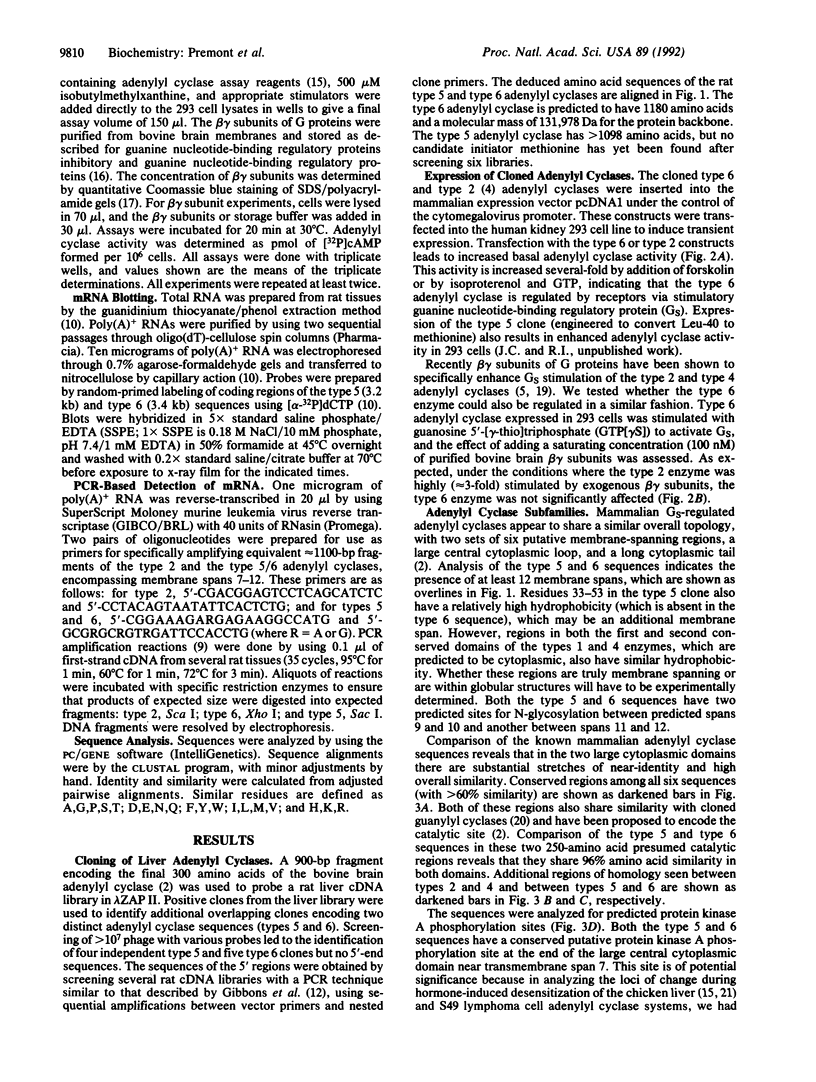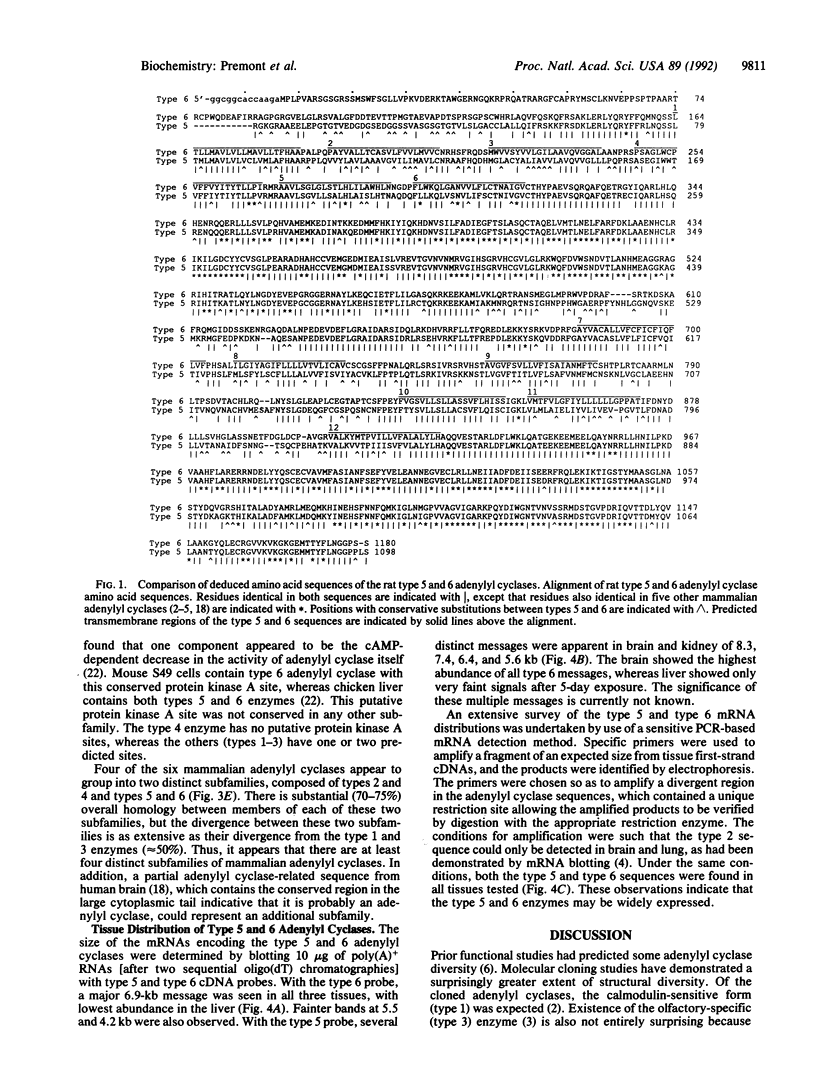Abstract
cDNA encoding a hormone- and guanine nucleotide-stimulated adenylyl cyclase [ATP pyrophosphate-lyase (cyclizing), EC 4.6.1.1] (type 6) from rat liver and kidney has been cloned and expressed. This enzyme is stimulated by forskolin, guanosine 5'-[gamma-thio]triphosphate, and isoproterenol plus GTP but is not stimulated by beta gamma subunits of guanine nucleotide-binding proteins. A second form (type 5), which is 75% similar to type 6, has also been cloned. Both types 5 and 6 cDNAs have multiple messages. PCR-based detection of the mRNA for the type 5 and 6 enzymes indicates that both are widely distributed. Homology analyses indicate at least four distinct subfamilies of guanine nucleotide stimulatory protein-regulated adenylyl cyclases. Types 5 and 6 enzymes define one distinct subfamily of mammalian adenylyl cyclases. Diversity of one guanine nucleotide-binding protein-regulated effector may allow different modes of regulation of cell-surface signal transmission.
Full text
PDF




Images in this article
Selected References
These references are in PubMed. This may not be the complete list of references from this article.
- Bakalyar H. A., Reed R. R. Identification of a specialized adenylyl cyclase that may mediate odorant detection. Science. 1990 Dec 7;250(4986):1403–1406. doi: 10.1126/science.2255909. [DOI] [PubMed] [Google Scholar]
- Burnham C. E., Hawelu-Johnson C. L., Frank B. M., Lynch K. R. Molecular cloning of rat renin cDNA and its gene. Proc Natl Acad Sci U S A. 1987 Aug;84(16):5605–5609. doi: 10.1073/pnas.84.16.5605. [DOI] [PMC free article] [PubMed] [Google Scholar]
- Carty D. J., Premont R. T., Iyengar R. Quantitative immunoblotting of G-protein subunits. Methods Enzymol. 1991;195:302–315. doi: 10.1016/0076-6879(91)95175-j. [DOI] [PubMed] [Google Scholar]
- Cooper D. M. Bimodal regulation of adenylate cyclase. FEBS Lett. 1982 Feb 22;138(2):157–163. doi: 10.1016/0014-5793(82)80431-6. [DOI] [PubMed] [Google Scholar]
- Feinstein P. G., Schrader K. A., Bakalyar H. A., Tang W. J., Krupinski J., Gilman A. G., Reed R. R. Molecular cloning and characterization of a Ca2+/calmodulin-insensitive adenylyl cyclase from rat brain. Proc Natl Acad Sci U S A. 1991 Nov 15;88(22):10173–10177. doi: 10.1073/pnas.88.22.10173. [DOI] [PMC free article] [PubMed] [Google Scholar]
- Gao B. N., Gilman A. G. Cloning and expression of a widely distributed (type IV) adenylyl cyclase. Proc Natl Acad Sci U S A. 1991 Nov 15;88(22):10178–10182. doi: 10.1073/pnas.88.22.10178. [DOI] [PMC free article] [PubMed] [Google Scholar]
- Gibbons I. R., Asai D. J., Ching N. S., Dolecki G. J., Mocz G., Phillipson C. A., Ren H., Tang W. J., Gibbons B. H. A PCR procedure to determine the sequence of large polypeptides by rapid walking through a cDNA library. Proc Natl Acad Sci U S A. 1991 Oct 1;88(19):8563–8567. doi: 10.1073/pnas.88.19.8563. [DOI] [PMC free article] [PubMed] [Google Scholar]
- Ishikawa Y., Katsushika S., Chen L., Halnon N. J., Kawabe J., Homcy C. J. Isolation and characterization of a novel cardiac adenylylcyclase cDNA. J Biol Chem. 1992 Jul 5;267(19):13553–13557. [PubMed] [Google Scholar]
- Jones D. T., Reed R. R. Golf: an olfactory neuron specific-G protein involved in odorant signal transduction. Science. 1989 May 19;244(4906):790–795. doi: 10.1126/science.2499043. [DOI] [PubMed] [Google Scholar]
- Katada T., Bokoch G. M., Smigel M. D., Ui M., Gilman A. G. The inhibitory guanine nucleotide-binding regulatory component of adenylate cyclase. Subunit dissociation and the inhibition of adenylate cyclase in S49 lymphoma cyc- and wild type membranes. J Biol Chem. 1984 Mar 25;259(6):3586–3595. [PubMed] [Google Scholar]
- Katsushika S., Chen L., Kawabe J., Nilakantan R., Halnon N. J., Homcy C. J., Ishikawa Y. Cloning and characterization of a sixth adenylyl cyclase isoform: types V and VI constitute a subgroup within the mammalian adenylyl cyclase family. Proc Natl Acad Sci U S A. 1992 Sep 15;89(18):8774–8778. doi: 10.1073/pnas.89.18.8774. [DOI] [PMC free article] [PubMed] [Google Scholar]
- Koesling D., Böhme E., Schultz G. Guanylyl cyclases, a growing family of signal-transducing enzymes. FASEB J. 1991 Oct;5(13):2785–2791. doi: 10.1096/fasebj.5.13.1680765. [DOI] [PubMed] [Google Scholar]
- Krupinski J., Coussen F., Bakalyar H. A., Tang W. J., Feinstein P. G., Orth K., Slaughter C., Reed R. R., Gilman A. G. Adenylyl cyclase amino acid sequence: possible channel- or transporter-like structure. Science. 1989 Jun 30;244(4912):1558–1564. doi: 10.1126/science.2472670. [DOI] [PubMed] [Google Scholar]
- Lazard D., Zupko K., Poria Y., Nef P., Lazarovits J., Horn S., Khen M., Lancet D. Odorant signal termination by olfactory UDP glucuronosyl transferase. Nature. 1991 Feb 28;349(6312):790–793. doi: 10.1038/349790a0. [DOI] [PubMed] [Google Scholar]
- Padrell E., Carty D. J., Moriarty T. M., Hildebrandt J. D., Landau E. M., Iyengar R. Two forms of the bovine brain Go that stimulate the inositol trisphosphate-mediated Cl- currents in Xenopus oocytes. Distinct guanine nucleotide binding properties. J Biol Chem. 1991 May 25;266(15):9771–9777. [PubMed] [Google Scholar]
- Parma J., Stengel D., Gannage M. H., Poyard M., Barouki R., Hanoune J. Sequence of a human brain adenylyl cyclase partial cDNA: evidence for a consensus cyclase specific domain. Biochem Biophys Res Commun. 1991 Aug 30;179(1):455–462. doi: 10.1016/0006-291x(91)91392-p. [DOI] [PubMed] [Google Scholar]
- Pfeuffer T. Synthesis of forskolin-agarose affinity matrices. Methods Enzymol. 1991;195:44–51. doi: 10.1016/0076-6879(91)95153-b. [DOI] [PubMed] [Google Scholar]
- Premont R. T., Iyengar R. Glucagon-induced desensitization of adenylyl cyclase in primary cultures of chick hepatocytes. Evidence for multiple pathways. J Biol Chem. 1988 Nov 5;263(31):16087–16095. [PubMed] [Google Scholar]
- Premont R. T., Iyengar R. Heterologous desensitization of the liver adenylyl cyclase: analysis of the role of G-proteins. Endocrinology. 1989 Sep;125(3):1151–1160. doi: 10.1210/endo-125-3-1151. [DOI] [PubMed] [Google Scholar]
- Salomon Y., Londos C., Rodbell M. A highly sensitive adenylate cyclase assay. Anal Biochem. 1974 Apr;58(2):541–548. doi: 10.1016/0003-2697(74)90222-x. [DOI] [PubMed] [Google Scholar]
- Short J. M., Fernandez J. M., Sorge J. A., Huse W. D. Lambda ZAP: a bacteriophage lambda expression vector with in vivo excision properties. Nucleic Acids Res. 1988 Aug 11;16(15):7583–7600. doi: 10.1093/nar/16.15.7583. [DOI] [PMC free article] [PubMed] [Google Scholar]
- Tang W. J., Gilman A. G. Type-specific regulation of adenylyl cyclase by G protein beta gamma subunits. Science. 1991 Dec 6;254(5037):1500–1503. doi: 10.1126/science.1962211. [DOI] [PubMed] [Google Scholar]
- Ui M., Okajima F., Itoh H. ADP-ribosylation of the inhibitory guanine nucleotide regulatory protein (Ni) as a possible mechanism underlying development of beta-adrenergic responses during primary culture of rat hepatocytes. Adv Cyclic Nucleotide Protein Phosphorylation Res. 1985;19:195–205. [PubMed] [Google Scholar]
- Vogel U. S., Dixon R. A., Schaber M. D., Diehl R. E., Marshall M. S., Scolnick E. M., Sigal I. S., Gibbs J. B. Cloning of bovine GAP and its interaction with oncogenic ras p21. Nature. 1988 Sep 1;335(6185):90–93. doi: 10.1038/335090a0. [DOI] [PubMed] [Google Scholar]
- Wong Y. H., Federman A., Pace A. M., Zachary I., Evans T., Pouysségur J., Bourne H. R. Mutant alpha subunits of Gi2 inhibit cyclic AMP accumulation. Nature. 1991 May 2;351(6321):63–65. doi: 10.1038/351063a0. [DOI] [PubMed] [Google Scholar]
- Yoshimura M., Cooper D. M. Cloning and expression of a Ca(2+)-inhibitable adenylyl cyclase from NCB-20 cells. Proc Natl Acad Sci U S A. 1992 Aug 1;89(15):6716–6720. doi: 10.1073/pnas.89.15.6716. [DOI] [PMC free article] [PubMed] [Google Scholar]




